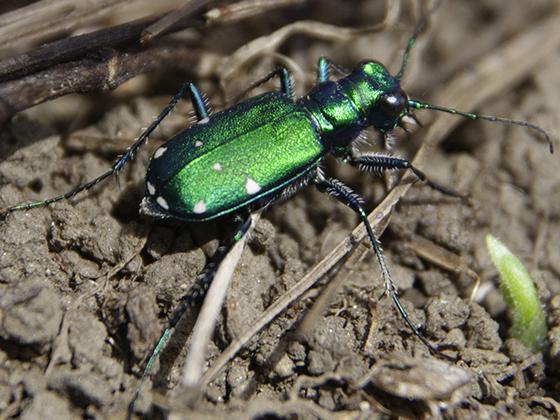
A six-spotted tiger beetle (Cicindela sexguttata). Credit: James Reben. All Rights Reserved.
Habitat will dictate whether ground beetles win or lose against climate change
Posted on March 23, 2023UNIVERSITY PARK, Pa. — The success of North American crops from corn to Christmas trees partly depends on a relatively invisible component of the food web — ground beetles. Nearly 2,000 species of ground beetle live in North America. New research led by Penn State shows that some of these insects could thrive while others could decline as the climate changes. The team found that the response will largely depend on the species’ traits and habitats and could have significant implications for conservation efforts.
“We know that climate change influences everything from coral reefs in the ocean to trees on land, but there’s less information available on how it affects insects,” said Tong Qiu, assistant professor of multifunctional landscapes at Penn State. “Ground beetles are everywhere — in your backyard, in your garden. They eat the pests and weed seeds that damage crops and are important food sources for birds. They are small insects, but they have large ecosystem impacts.”
The idea for the project came after Qiu and his colleagues read two studies with diverging findings. Both studies looked at the trends of insect population by aggregating the findings of existing literature, with one study showing a decline in terrestrial insect populations over the past 100 years and the other showing no change. Qiu and his collaborators wondered what the picture would look like if they examined species as a group, or “community,” but allowing for their differing traits, using raw data that were collected across the continent.
The researchers studied 136 ground beetle species found in diverse habitats across North America, Puerto Rico and Hawaii. They retrieved ground beetle count data from the National Science Foundation’s National Ecological Observatory Network (NEON) and 11 previously published studies to measure the beetles’ distribution across the continent. The researchers categorized the species by a number of traits — such as preferred habitat, body size, and whether they fly, burrow, climb or run — to generalize their responses to climate change.
The scientists collected habitat information such as gaps in forest canopy and the density of plants and logs on the forest floor from NEON’s Airborne Observation Platform (AOP). AOP conducts low-altitude flights with imaging instruments that measure a wide spectrum of light to create detailed 3D images of landscapes.
The scientists entered the species and habitat data into an advanced statistical model and ran moderate to high greenhouse gas emission scenarios to study how the ground beetles respond to a changing climate. Among their results, they found that less mobile, nonflying beetle species could decline over time, but habitat conservation can mitigate the effects of climate change and reverse the trend in some areas. They reported their findings today (March 23) in the journal Global Ecology and Biogeography.
“We found that nonflying carnivores, which are critical pest control agents, are more likely to decline over time in a warmer, dryer climate,” said Qiu, who is also an associate of Penn State’s Institute for Computational and Data Sciences. “If you have fewer carnivores, you’ll have more of the pests that can impact agriculture.”
Habitat conditions can play a large role in beetle population change and can actually reverse the trend, according to the researchers. Gaps in forest canopy are beneficial for many ground beetles that require open ground to pursue prey. Other habitats, such as those with dense understory plants and fallen tree logs, offer important microclimate conditions that help to mitigate the effects of climate change, said Qiu.
“We hope conservation biologists will use the information in this paper and the online map that we created to better manage habitats for insects in general,” he said. “Ground beetles are very beneficial to ecosystems, but they’re largely invisible to the average person. In this paper we’re showing the broad impacts they have on whole communities in forested and agricultural ecosystems.”
Aaron Bell, University of Saskatchewan; Jennifer Swenson, Duke University; and James Clark, Duke University and Université Grenoble Alpes, contributed to this work.
The National Science Foundation, Belmont Forum, NASA and the Programme d’Investissement d’Avenir under project FORBIC supported the study.
From Penn State News
